2 Endoscopic Anatomy of the Nose and Paranasal Sinuses
Anatomical textbooks and atlases offer very accurate descriptions of the structure and topography of the nose and the paranasal sinuses, but the details have been worked out from macroscopic laminar sections on cadaver dissections. However, intranasal surgeons must be able to orientate themselves looking through straight or angled endoscopes. They must develop a three-dimensional mental image allowing them to know exactly where they are, where the ducts and the danger points lie, and what structures are closely related. Endoscopic topographical anatomy, therefore, must be studied by imitating surgical approaches.
This chapter begins with a basic orientation on endoscopic landmarks within the nasal cavity. This is supplemented by a series of CT images to facilitate comprehension and a three-dimensional perception of the surgical field. Step-by-step descriptions of typical operative maneuvers during an anatomical dissection follow and may serve as a manual for training courses.
The Nasal Cavity and Its Endoscopic Landmarks
The medial nasal wall–the nasal septum–is simple and smooth, unlike the highly complex lateral nasal wall, the area of interest for the endoscopic surgeon (Fig. 2.1). The ducts and ostia, covered by the nasal turbinates, form the entrances to the paranasal sinuses. The size and position of the lateral nasal wall vary widely, dictated by the paranasal sinuses. The following endoscopic views should be mentally projected onto the complex of the lateral nasal wall. When the endoscope, usually the 25° telescope, is introduced into the nostril, it impinges immediately on the vibrissae of the nasal vestibule obstructing the view of the nasal valve; therefore, these hairs should be trimmed before an endoscopic procedure (Fig. 2.2). The nasal valve is formed by the floor of the nose, the septum and the lower edge of the upper lateral cartilage tilted inward. Anteriorly, the septum and the fl oor of the nose usually have ridges on both sides arising from the premaxilla. The slitlike opening could hinder the view during intranasal surgery, so preliminary septal correction can be useful; the necessary access may also be widened using a nasal speculum.

Fig. 2.1 The lateral nasal wall, showing the middle and inferior turbinates and the rudiment of a superior turbinate. The sagittal section through the skull shows the topographical relationships with the anterior skull base, the sphenoid sinus, and the nasopharynx. Behind the latter lie the brainstem and the cervical spine. ↑ = tubal orifice.
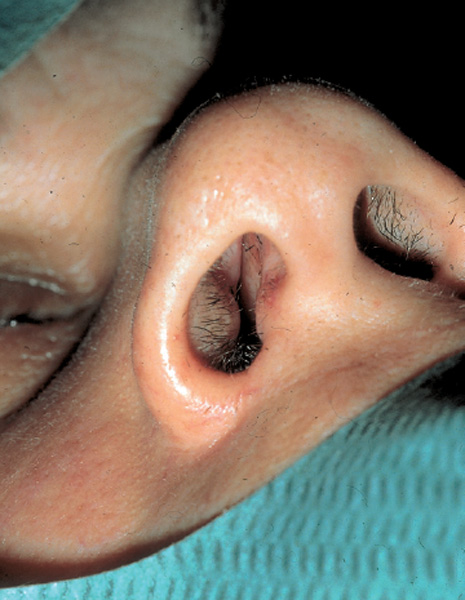
Fig. 2.2 The nostrils with narrowing of the nasal vestibule by the process of the alar cartilage (medially) and by the projection of the superior edge of the alar cartilage and the lower edge of the triangular cartilage lying laterally.
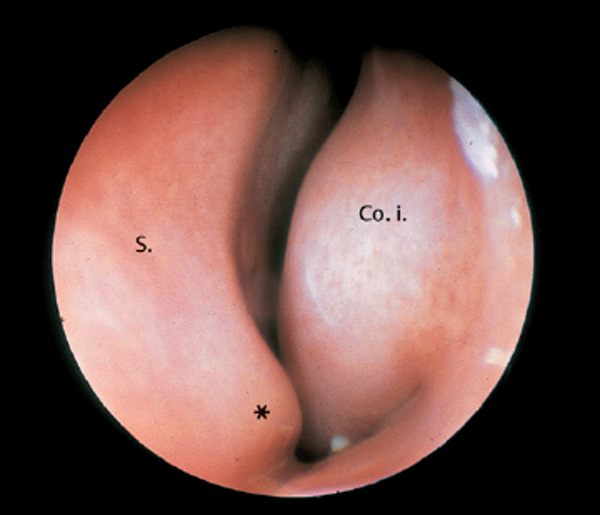
Immediately behind the nasal valve lies the second narrow point: the anterior end of the inferior turbinate takes up two-thirds of the field of vision and divides the inspiratory air stream into an upper and a lower pathway (Fig. 2.3).
The visual field can be broadened by vigorous decongestion of the mucosa with pledgets soaked in 1/1000 epinephrine solution. However, the bone of the anterior end of the turbinate may be large and may obstruct the view, requiring limited resection. The body of the turbinate consists of the rigid turbinate bone and erectile tissue (Fig. 2.4) covering its medial surface. The lateral wall of the turbinate is shaped like a gutter, so that the border between the mucosal surfaces is tilted externally. The inferior meatus lies lateral to the inferior turbinate: its lateral wall is the lowest part of the lateral nasal wall. The line of insertion of the turbinate bone is concave downward (Fig. 2.5), and lacks any particular landmarks. Its bony wall is thinnest at the center, just below the apex of the curve, and antral puncture is most easily carried out at this point. The anterior insertion of the inferior turbinate may lie only 2–3 mm above the floor of the nose, so that an endoscope may be introduced only with difficulty beneath the inferior meatus, leaving little space for an accompanying instrument (Fig. 2.6). A vertical incision through the mucosa and bone may then be needed at this point to allow the turbinate to be displaced medially and upward.
The lacrimal canal opens immediately behind and about 2 mm below the anterior insertion of the turbinate. Its slitlike opening into the anterosuperior part of the inferior meatus (Fig. 2.7) must be strictly respected when creating an inferior meatal antrostomy using the punch. Endoscopic exposure of the lacrimal sac and canal is considerably helped by identification of its nasal ostium. Figure 2.5 shows the course of the lacrimal canal in the lateral nasal wall of a cadaver (see also Fig. 2.36f).

Fig. 2.4 Histological appearance of a transverse section through the inferior turbinate. The spongiform erectile tissue is rich in vessels and is covered by thick veins, particularly medially. Numerous mucosal glands lie in the respiratory epithelium (Elastica–van Gieson,×7).
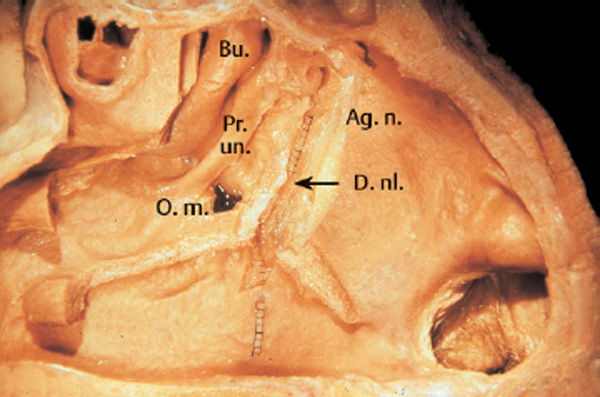
Fig. 2.5 The left lateral nasal wall (dissection by Prof. Dr. J. Lang, Würzburg, Germany). The inferior and middle turbinates have been removed, and the superior turbinate has been fenestrated. The complex consisting of the middle turbinate with the uncinate process, the semilunar hiatus, the bulla, and a superior nasal meatus can be recognized. The lacrimal duct has been exposed as far as its opening into the inferior meatus (mm scale). The anterior fontanelle marks a secondary ostium of the antral cavity.
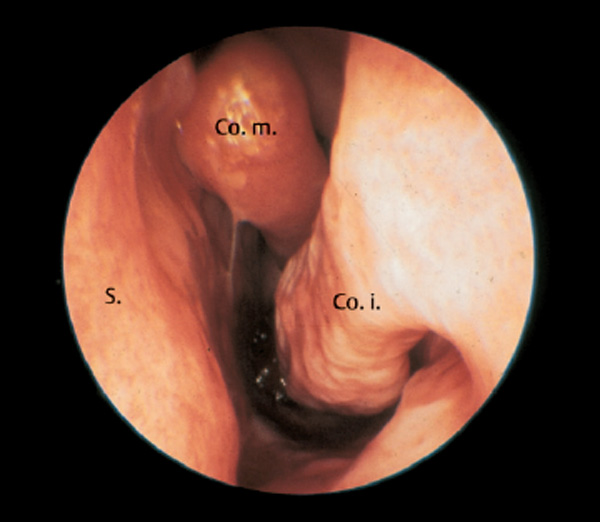
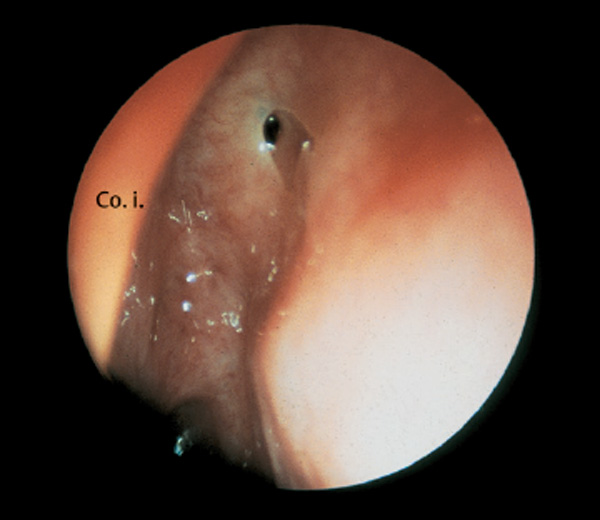
Fig. 2.7 Left inferior meatus with the ostium of the lacrimal duct (70° telescope with a view superiorly).
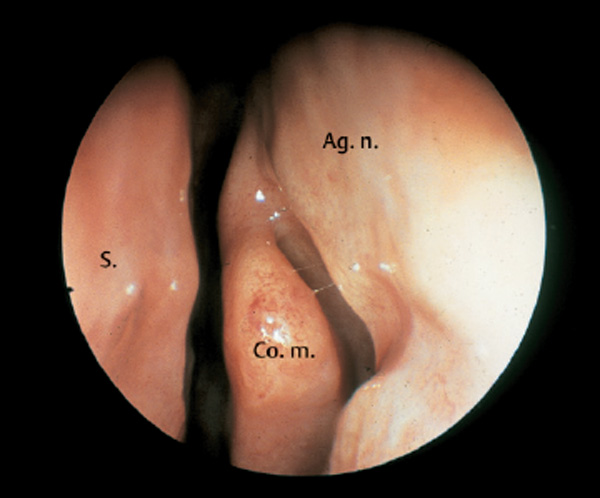
Fig. 2.8 Left nasal cavity with the anterior insertion of the middle turbinate close behind the agger nasi (70° telescope with a view in a superior direction).
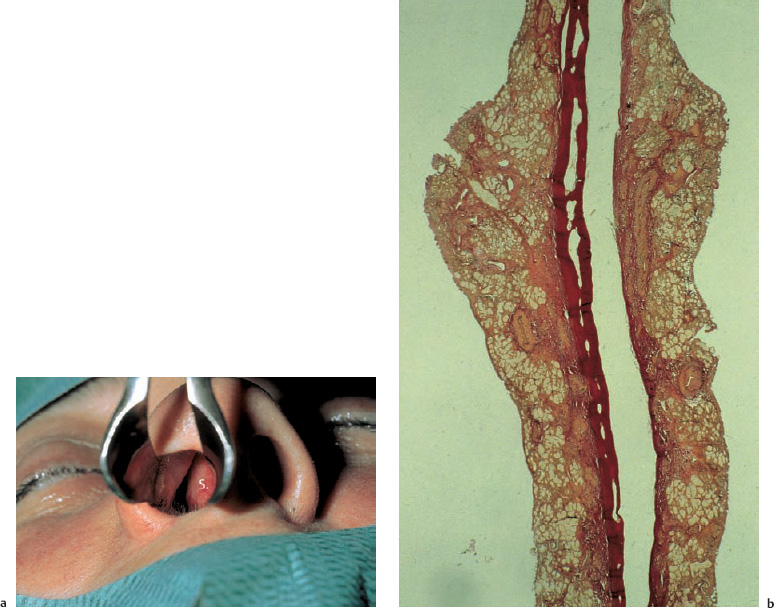
Fig. 2.9 a, b Superior narrowing of the common nasal meatus by the piriform aperture (laterally) and thickening of the septum (medially).
a Clinical photograph.
b The histological appearances show that the “pseudodeviation” of the nasal septum is a rudimentary erectile tissue body rich in glands and vessels (Elastica–van Gieson,×4).
Ascending superiorly from the nasal vestibule, the next structure to come into view is the agger nasi, a smooth, bony swelling lying in front of the anterior insertion of the middle turbinate (Fig. 2.8). It may be pneumatized and thin-walled, and contain the agger nasi cells; more often it has a thick bony wall. Lateral to the agger nasi lies the outflow tract of the frontal sinus, the frontonasal duct. This is normally approached from the semilunar hiatus via the ethmoidal infundibulum, but after ethmoidectomy and clearance of the infundibulum it is entered directly from the nasal cavity. Identification of the agger nasi at the nasal introitus is therefore important. The agger nasi is also an important landmark for endoscopic exposure of the nasolacrimal canal : the canal lies lateral to the lateral nasal wall at the same level as the agger nasi or 1–2 mm in front of it. It runs parallel to the agger, after running medially under some ethmoidal cells. This proximity explains why the lacrimal canal is in danger in the region around the ethmoid cells in massive polyposis with bony erosion. The frontal sinus, the nasolacrimal duct, and the agger nasi lie in roughly the same frontal plane.
Passage of the endoscope into the common nasal meatus beyond the narrow area at the anterior end of the inferior turbinate is often hindered further on by a ridge on the lower edge of the nasal septum. This is formed by the premaxilla and the palatal ridge of the maxilla onto which impinges the lower edge of the septal cartilage. An accessory (Huschke’s) cartilage also lies at this point. More superiorly, the septum again restricts visibility of the nasal roof: an apparent upper septal deviation is actually a widening of the septum (Fig. 2.9a, b) , the tuberculum septi (Zuckerkandl 1882). It is present on both sides and histologically it is formed by rudimentary erectile tissue. In addition, a widening of the bony septum may be hidden beneath it. The CT images in Figure 2.22 b–f show its relation to the base of the skull. It is almost impossible to remove it without damaging the mucosa; if it is well developed and is obstructing drainage, it may have a very unfavorable influence on the healing of the ethmoid gutter after ethmoidectomy. Synechiae often arise in this area where the septum is broad after rough extraction of nasal polyps.
Further backward, the endoscope impinges on another obstruction, the oblique ascending septal ridge formed by the edge of the vomer and the posterior end of the quadrangular cartilage (Fig. 2.10). It may even impinge upon the middle turbinate and protrude into the middle meatus, affecting the air stream. To bring the nasal choana into view, the endoscope must be passed beneath the ascending septal ridge rather than over it. The mucosa along the ridge is usually atrophic and vulnerable.
The lower posterior nasal region and the choanae (Fig. 2.11) can almost always be inspected with a 0° or 25° rigid or flexible telescope passed along the floor of the nose. In adults the choanae are 1.5–2.0 cm high, and form an important landmark (Fig. 2.12).
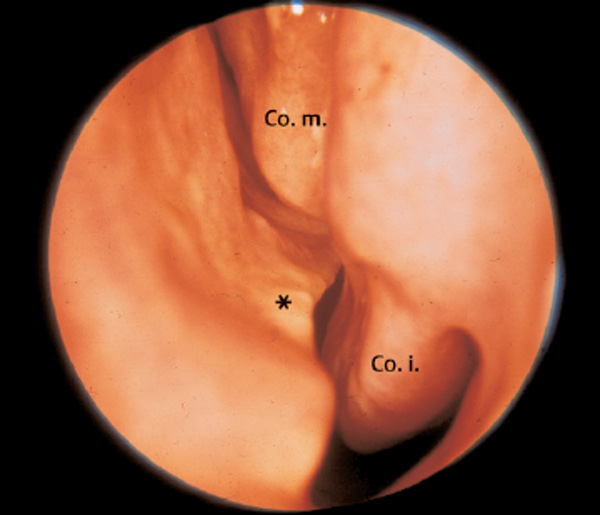
Fig. 2.10 Marked narrowing of the left common nasal meatus by a vomerine ridge (*) running posteriorly and upward, and impinging upon the atrophic inferior turbinate. The body of the middle turbinate lies on the ridge (30° telescope).
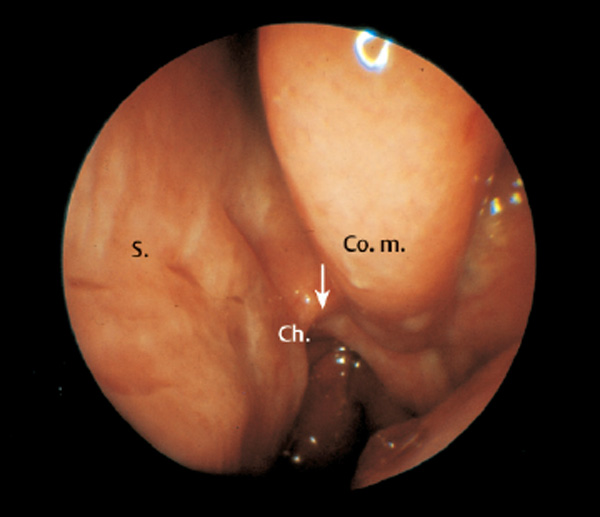
Fig. 2.11 Posterior part of the left nasal cavity. The straight telescope lies between the inferior turbinate and the free edge of the middle turbinate, and the upper edge of the choana (arrow) can be seen in the center of the field of vision.
The posterior end of the inferior turbinate projects into the lower part of the posterior nasal choana from the lateral side, occupying up to half of its height. It is often hypertrophic, resembling a mulberry, and then can considerably narrow the choana. The posterior insertion of the middle turbinate lies in the upper third of the choana, just in front of its anterior edge (Fig. 2.13). This point of attachment forms a landmark for the front wall of the sphenoid sinus: a thin point in the bony wall of the anterior sphenoidal sinus can be found and perforated lying a little more than 1 cm above and 0.5 cm medially. This point can also be palpated 1 cm above the dome of the choana paramedially. The sphenoidal ostium lies higher and somewhat more medial. It is seldom suitable for access to the sphenoidal sinus. The posterior third of the middle turbinate lies in the same sagittal plane as the lateral wall of the sphenoid sinus. The posterior end of the inferior turbinate and the ostium of the eustachian tube lie at the same level, and in the same sagittal plane, but are separated by the choana (Fig. 2.13).
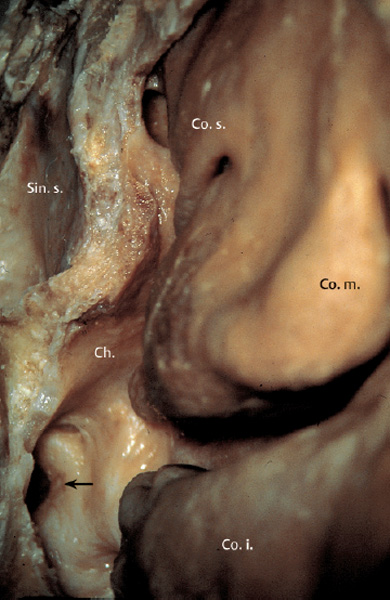
The middle meatus is the most important region for endoscopic nasal examination: it is the normal entrance to the ethmoid, frontal, and maxillary sinuses, and also provides a portal for their surgical exposure. It can only be seen properly after displacing the middle turbinate medially. Figure 2.14 shows a cadaver dissection after removal of the middle turbinate. The middle meatus extends over two-thirds of the length of the lateral nasal wall between the cut edge of the middle turbinate and the upper edge of the inferior turbinate. After removal of the soft tissues, the bony specimen (Fig. 2.15) shows the relationships in the middle meatus: the ethmoid process ascending from the turbinate bone divides the membranous part of the lateral nasal wall into an anterior and a posterior fontanelle. Usually a small spicule of bone runs toward it from the uncinate process. The endoscopic view (Fig. 2.16) in the cadaver shows the ethmoid bulla, forming the lower limit of the ethmoid cell system, and the lateral boundary of the middle turbinate. The bulla also forms the upper edge of the semilunar hiatus. The most anterior ethmoid cells, the maxillary sinus, and the frontal sinus drain into the hiatus; the frontal sinus opens into the ethmoid infundibulum, the most anterior, upwardpointing and deeply etched prolongation of the hiatus. The hiatus and the infundibulum are usually not visible with the endoscope, so that the primary maxillary ostium cannot be inspected.
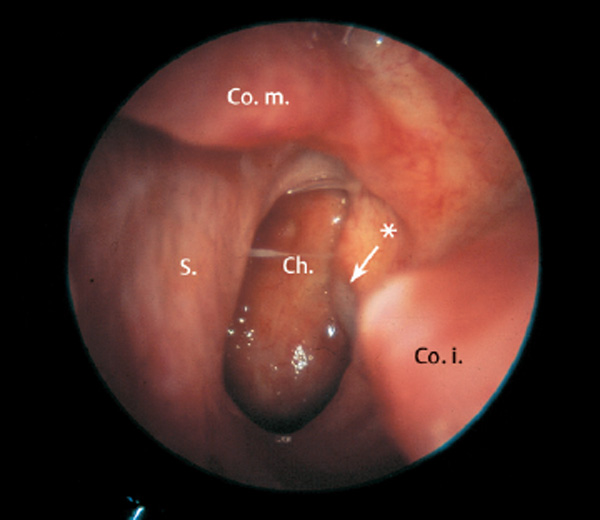
Fig. 2.13 The choana in endoscopic view from in front with a straight telescope on the floor of the nose. The posterior end of the inferior turbinate and the ostium of the eustachian tube (*) lie at the same level, and require care during posterior turbinectomy. In this case the posterior attachment of the middle turbinate crosses the roof of the choana.

Fig. 2.14 The lateral nasal wall with the sphenoid sinus in an anatomical dissection after removal of the body of the middle turbinate. Between the upper edge of the inferior turbinate and the lower edge of the uncinate process this membranous part of the lateral nasal wall has a height of 1 cm. The ethmoidal bulla (*) hangs into the middle meatus and partially covers the semilunar hiatus. The continuation of the middle turbinate running obliquely upward and suspended laterally from the lateral nasal wall can be seen. Above it lies a superior turbinate and the rudiment of a supreme turbinate. The ostium of the sphenoidal cavity is visible as a shadow (arrow).

Fig. 2.15 The left lateral wall in a macerated bone. The ethmoid process of the turbinate bone (*), directed superiorly in this case, divides the bone-free wall of the antral cavity into a small anterior and a large posterior fontanelle. The uncinate process bounds the semilunar hiatus and the ethmoid infundibulum, which is separated from it from below and medially. The ethmoid bulla projecting above the hiatus is opened, demonstrating cells of the anterior and middle ethmoids. Above the basal lamella of the middle turbinate lie the posterior ethmoid cells. The most posterosuperior cells cover the canal for the optic nerve. For. sp. = sphenopalatine foramen.
Between the curved, anteriorly projecting uncinate process and the insertion of the inferior turbinate lies a smooth strip of the lateral wall of the middle nasal meatus, 2–4 mm high. This area is partly bony and partly membranous, the latter being formed by the fontanelles, and it often contains an opening into the maxillary sinus, the secondary ostium (Fig. 2.17). The relationships of the middle meatus to the ethmoid sinuses, to the maxillary and frontal sinuses, and particularly to the orbit must be studied with great care before beginning intranasal surgery. These are particularly well shown by a series of coronal CT images (see Fig. 2.22a–n).
The middle turbinate is of central importance in endoscopic surgery: its body is integrated into the ethmoid cell system (Fig. 2.18) so that ethmoid disease extends into the middle turbinate but not into the inferior turbinate. The medial lamella of the middle turbinate is inserted anteriorly into the skull base: it conducts fibers from the olfactory nerve and is partly covered with olfactory mucosa, and thus forms part of the olfactory region. In contrast, the posterior part of the turbinate is anchored relatively loosely to the ethmoid bone (Fig. 2.19a, b) , and only its posterior edge is attached to the lateral nasal wall (see Fig. 2.13). As a result, good exposure of the posterosuperior ethmoid cells can only be achieved by partial resection of the middle turbinate (Fig. 2.20). The junction of the part attached to the skull base and the dependent ethmoid bone lies at the posterior edge of the cribriform plate. It can be easily recognized during intranasal endoscopy, and is thus an important landmark.
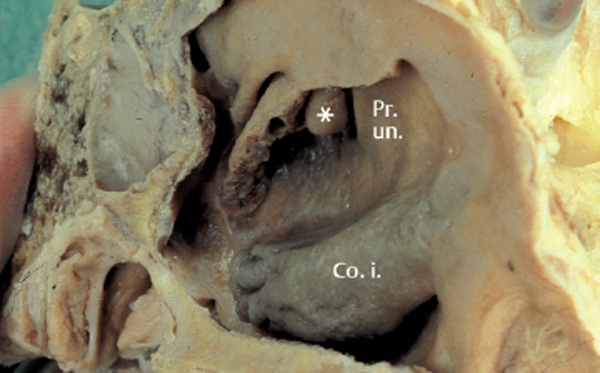
Fig. 2.16 The lateral wall in an anatomical dissection similar to that of Figure 2.14 viewed from in front. * = bulla.
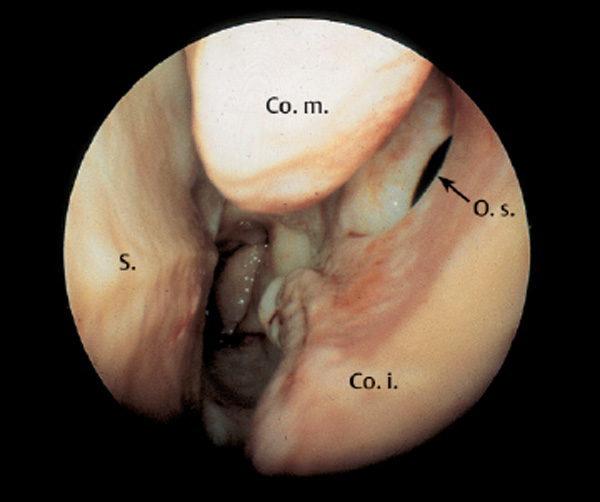
Fig. 2.17 Endoscopic view through a straight telescope of the middle meatus with a secondary ostium in the posterior fontanelle of an anatomical dissection. The middle turbinate conceals the semilunar hiatus.
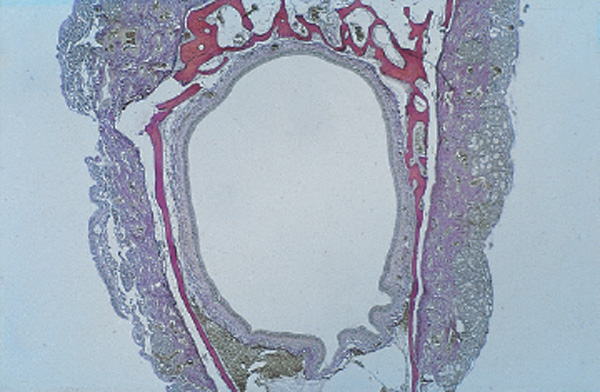
Fig. 2.18 Pneumatized middle turbinate (concha bullosa). The hollow space in the free body of the middle concha is lined with respiratory mucosa (Elastica–van Gieson).
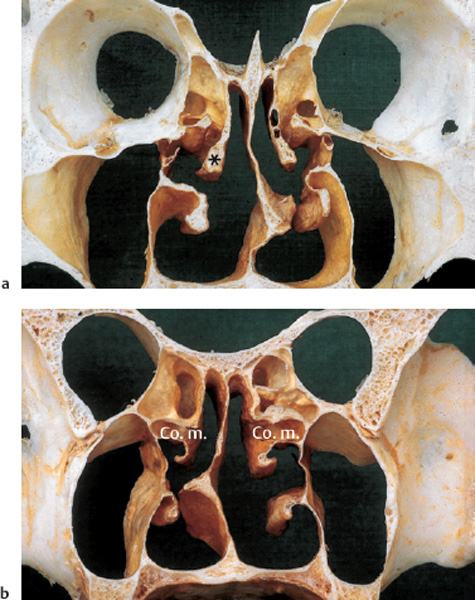
Fig. 2.19 a, b Coronal section through a dissected skull showing the view from in front.
a. The medial lamella of the middle turbinate (*) inserting into the skull base at the level of the crista galli, immediately lateral to the edge of the cribriform plate.
b. More posterior section: The ethmoid roof is thickly ossified at the level of the sphenoid plane, and the medial lamella of the middle turbinate now inserts into the ethmoid or into the lateral nasal wall. Above it, the latter is identical with the orbital wall.
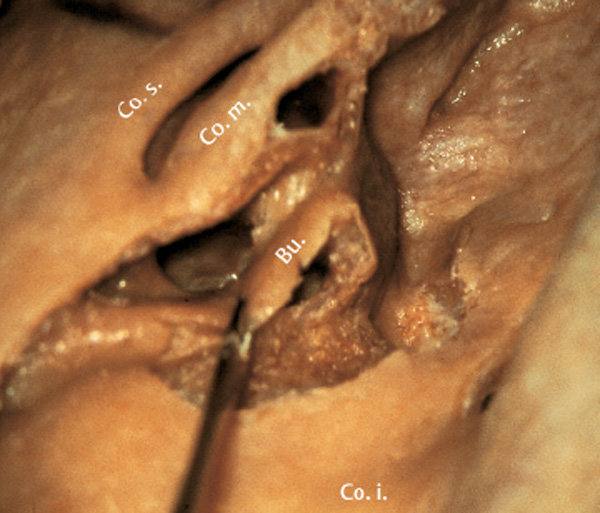
Fig. 2.20 Posterior ethmoid cells in an anatomical dissection. These cells lie lateral to and above the divided middle turbinate. A needle is pressing the opened bulla downward. The picture explains why the middle turbinate often floats freely and tears off if it is not removed and its posterior tip is not preserved during an extensive posterior ethmoidectomy.

Fig. 2.21 a, b The olfactory cleft.
a. View upward into the nasal cavity with a 70° telescope. The common nasal meatus narrows medial to the middle turbinate to form the olfactory cleft.
b. Diagram of the olfactory area. The septum has been turned upward (from Bucher, O., Cytologie, Histologie und Mikroskopische Anatomie des Menschen, 8th edition, Huber, Bern 1973).
In front of this junction, the middle turbinate carries olfactory fibers, so that destruction of the bony base of the turbinate carries the danger of tearing these fibers, inducing a CSF fistula. Behind this junction, in contrast, the ethmoid roof may be exposed as far as the septum without great danger of a CSF fistula.
The superior nasal meatus is difficult to inspect, particularly if the septum is widened or deviated. In front, it contains the olfactory cleft , a narrow slit extending superiorly between the middle turbinate and the nasal septum to the roof of the nose (Fig. 2.21a, b) , and covered on both sides by olfactory mucosa. Posteriorly, the superior nasal meatus is narrowed by the superior turbinate and by the downward-sloping anterior wall of the sphenoid sinus. The superior meatus is similarly narrowed if a supreme nasal turbinate is present, although the latter is usually recognizable only as a smooth swelling (see Fig. 2.20). The natural sphenoid ostium often cannot be recognized at endoscopy, but can occasionally be seen after displacing the middle turbinate and the superior turbinate laterally, although this may be difficult if the bone is hard (see Fig. 2.12). Its detection with the help of landmarks was recently studied by Kim et al. (2001).
A CT Imaging Study of the Spatial Arrangement of the Paranasal Sinuses
An important prerequisite for safe endoscopic surgery within the paranasal sinuses is a clear three-dimensional mental picture of their spatial relationships to each other and to the neighboring maxilla, orbit, sphenoid sinus, and anterior cranial fossa. This knowledge allows surgeons to avoid the danger areas while taking full advantage of the endoscopic technique, and gives them the confidence to continue the procedure rather than abandoning it prematurely because of groundless anxieties. The layout of the cell system can best be learnt step-by-step from a series of high-resolution CT images. However, even the most recent three-dimensional reconstructions of CT sections do not substitute for a laminar comparison of CT images and anatomical sections of the skull base as an optimal basis for exploration of these intercommunicating hollow spaces within the anterior skull base.
Vertical Coronal Sections (Fig. 2.22)
Examination of coronal CT scans begins anteriorly at the root of the nose. The plane is tilted 10–20° backward from above downward, depending on the type of the apparatus and on the patient’s ability to extend the head while lying prone. The frontal sinus comes into view first (Fig. 2.22a–c) . Its extension superiorly and laterally varies between subjects, and the sinus is seldom symmetrical on the two sides. Extensive supraorbital niches indicate that an intranasal procedure will not reach the periphery of the sinus without an additional external approach (Fig. 2.23a, b).
The interfrontal septum is seldom in the midline and usually lies lateral to the nasal septum, an important fact in transnasal frontal sinusotomy. The outflow tract of the frontal sinus (the frontal infundibulum ) tapers inferiorly. It is often directed slightly posteriorly, and runs under the forward convexity of the posterior wall of the frontal sinus, sometimes displaced and narrowed by the internal nasal spine (Hosemann 2001). The transition to a true duct or opening into an anterior ethmoid cell may lie very deeply and vary considerably (Prott 1973). Superomedial to this point, the nasal roof is formed by the anterior edge of the olfactory cleft, and the crista galli is at its greatest extent at this point. Often the frontonasal duct impinges tightly on the orbital wall, whereas medial to it lie even smaller cell tracts that cannot be inspected.
The anterior ethmoid cells are very variable in shape. Sometimes they project into the frontal sinus; rarely supraorbital ethmoidal cells may also run laterally and above the frontal sinus so that the orbit has a doubly pneumatized upper layer. The prebullar cell system is divided up even more precisely (Terrier 1987) as follows:
• Uncinate cells with upper, anterior (agger), and posterior cells
• Anterior and posterior meatal cells
Classically, the upper uncinate cell opens into the frontal sinus, but the frontal sinus may also drain via the meatal cell. Bagatella and Guirado (1983) name these cell groups as follows:
• Preinfundibular cells (0–1 cell) with the agger nasi cell
• Lateral infundibular cells (0–2 cells)
• Postinfundibular cells (0–2 cells)
The varying development of these cells is the cause of the differences in the outflow tract of the frontal sinus.
The nasal septum can always be recognized easily on CT scans. Its height increases from anteriorly to the middle, reaches its maximum beneath the crista galli where it contacts the base of the skull in the midline, and then decreases toward the choana, to not quite half of its maximal size. The anterior soft-tissue bulge of the septum lying close to the anterior end of the inferior turbinate can always be recognized, and its varying cartilaginous and bony construction can be recognized over its entire length as far as the vomer.
The interfrontal septum in front and the intersphenoidal septum behind do not always lie in the same plane as the nasal septum. This is important information in transseptal sphenoidotomy. The asymmetrical insertion of the septum into the palate, and the varying level of the floor of the nose, can also be seen easily in CT images.
The lateral nasal wall must be examined systematically. Below it is typically convex, corresponding to the concavity of the medial antral wall, and above concave corresponding with the lateral ethmoid wall. The edge is convex into the nose and concave into the orbit (see Fig. 2.22f) . This relationship is usually constant between sides and between subjects, giving the surgeon confidence during sphenoidal-ethmoidal operations. Whereas the lateral wall of the ethmoid and nasal cavity thus forms a lazy “S” in frontal section, the continuation of the lateral ethmoid wall into the roof of the maxillary cavity forms a continuous curve without a step, an important point during intranasal maxillary operations and middle meatal antrostomy.
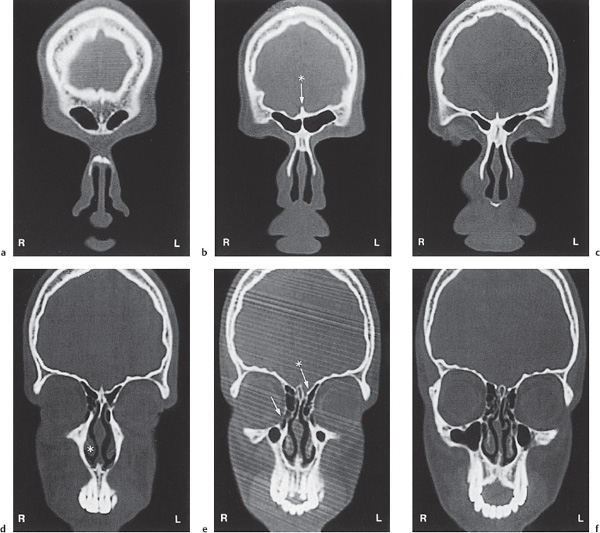
a. Section through both frontal sinuses just in front of the root of the nose
b. The interfrontal septum and anterior edge of the crista galli (*) in the midline. Root of the nose.
c. The infundibulum of the frontal sinus.
d. The crista galli, the infundibulum of the frontal sinus, and the anterior ethmoid cells are again shown. The end of the inferior turbinate lies in the piriform aperture (*). The upper incisor teeth are shown, and the section cuts across the lacrimal canal.
e. Paramedian oblique section (*) of the anterior skull base (olfactory fossa). Immediately lateral to the agger nasi lies the divided lacrimal canal marked with an arrow. Inferolateral to this lies the prelacrimal recess of the antral cavity. The crista galli is shown as a prolongation above the septum.
f. Pneumatized crista galli, depression due to the cribriform plate, the middle ethmoids, the middle turbinate beginning on the left, and a concave nasal floor.
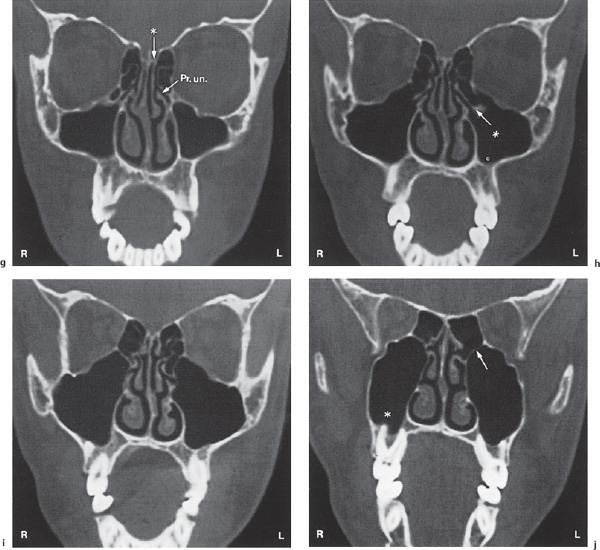
g. Coronal plane behind the lacrimal duct. The olfactory region with a steeply hollowed-out olfactory fossa can be seen. The medial lamella of the middle turbinate inserts into the base of the skull (*) and marks the outer edge of the narrow cribriform plate. The uncinate process and a bullar cell are visible on both sides. The lateral ethmoid wall is roughly the same height as the medial wall of the antrum.
h. End of the cribriform plate, with the middle turbinate still extending to the base of the skull. The middle ethmoid cells are shown at the level of the ethmoid bulla. A deep canal (↑) from the semilunar hiatus to the maxillary cavity (*) is shown over a high uncinate process. The antral cavities extending laterally now support the orbit completely.
i. The middle turbinates now insert into the ethmoids. The end of the ethmoid infundibulum on the left is well visible. The medial wall of the antrum has gained in height at the cost of the lateral ethmoid wall.
j. The posterior end of the ethmoid is considerably wider than the anterior, and its roof is flat and rigid. The root of a molar tooth (*) on the right side projects into the alveolar recess of the now high antral cavity. The party wall between the medial third of the antral roof and the ethmoid compartment is very thin, and is marked by an arrow.
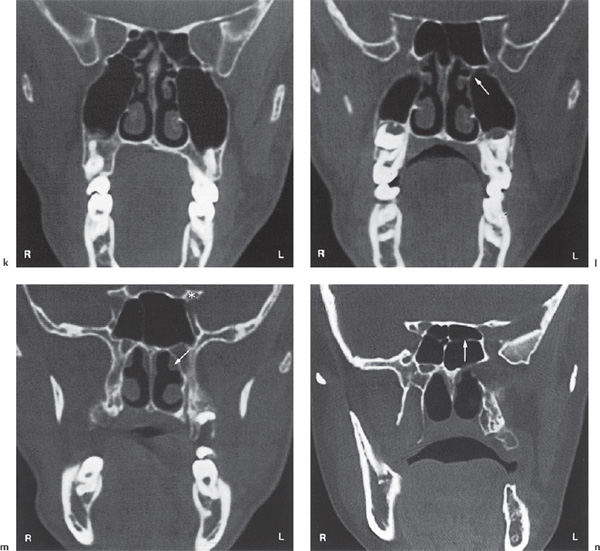
k. Posterior ethmoid immediately in front of the sphenoid cavity. The middle turbinate is now slender and shows a thin area of insertion into the lateral nasal wall (i. e., the medial antral wall). The ethmoid in this section is twice as wide as in front.
l. An asymmetrical sphenoid sinus immediately behind its anterior wall. The intersphenoid septum lies obliquely, above the nasal septum. The end of the antral cavity lies in front of the pterygoid process. The medial wall of the antrum is marked with an arrow.
m. A small right and a large left sphenoid sinus, and the clinoid process (*). The externally directed insertion of the middle turbinate lies on each side on the pterygoid process, marked with an arrow.
n. Sphenoid sinus lying over the posterior end of the nose and the posterior edge of the vomer. Its height is about the same as that of the choana. Ridges present in the posterior wall are marked with an arrow (different patient from that shown in a–m)
The point of intersection of the lateral nasal contour with the orbitomaxillary arch is an important landmark: 1–3 mm beneath it lies the primary maxillary ostium. This outflow tract often runs very close to the orbit, almost exactly in the same frontal plane in which the medial lamella of the middle turbinate swings away from the base of the skull to insert into the ethmoid (see Fig. 2.22h, i) . This point represents the posterior end of the olfactory cleft.
Whereas the point of intersection of the roof of the maxilla with the lateral wall of the nose or of the ethmoids lies about halfway up the nose, at the center it inclines upward due to the tapering of the orbit, until it breaks up in the root of the pterygoid process. Further posteriorly, the lateral wall of the ethmoid is continuous with the lateral wall of the sphenoid cavity without a step. This slightly bulging but smooth transition between the lateral sphenoid and ethmoid wall can be easily recognized on axial CT images. This detailed knowledge of anatomy facilitates complete removal of cells during intranasal ethmoidosphenoid operations.
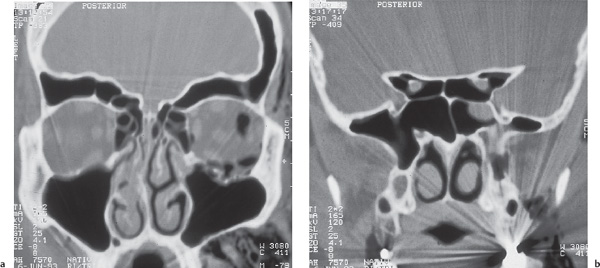
The shape of the maxillary cavity changes from anterior to posterior. In front it is triangular, in the middle it is kidney-shaped, and posteriorly it resembles a large almond with rounded contours. Familiarity with its upper (ethmoid) and lower (alveolar and palatine) recesses (Fig. 2.24) is important since they must be reached by instruments introduced through an inferior or middle meatal antrostomy.
Before intranasal procedures, particularly revision surgery, it is worthwhile estimating the relationship of the inferior turbinate to the nasal and maxillary cavities on serial three-dimensional sections. The extent of the obstruction of the common and inferior meatus by the turbinate bone is clear, although its absolute size varies with the nasal cycle. The turbinate extends along the entire length of the lateral nasal wall as far as the posterior choana, two-thirds of which can be obstructed by the thick posterior end of the turbinate.
The varying height of the inferior meatus and of the groove that it forms in the turbinate are particularly marked in frontal sections. Usually the free edge of the turbinate is tilted externally. The turbinate bone may also be curved externally but sometimes it forms only a narrow ridge in the center of the turbinate. A limited turbinectomy may be needed in some cases.
The middle turbinate is a key structure in intranasal surgery. Beneath and immediately lateral to it in the middle meatus lie the most important outflow tract of the paranasal sinuses, the ostia, and the ducts for the frontal, maxillary, and anterior ethmoid sinuses. Its shape is very variable: sometimes it is high and narrow with few or no cells; on other occasions it is plump and permeated by many cells that are difficult to assign either to the turbinate or the ethmoid, as the two merge with each other. Anteriorly, the medial lamella of the middle turbinate always extends to the dome of the nose, thus forming the lateral wall of the olfactory cleft (see Fig. 2.8), but posteriorly it deviates from the roof of the nose, curves more deeply and inserts into the ethmoid (see Fig. 2.19b) . Above it, the superior turbinate lies in the posterior half of the nose; alternatively, the ethmoid cells reach this point. The point at which the middle turbinate deviates from the anterior skull base is thus an important landmark which must be identified during ethmoidectomy, otherwise the medial surface of the turbinate can be torn off by rough technique, damaging the olfactory fibers and producing a CSF fistula.
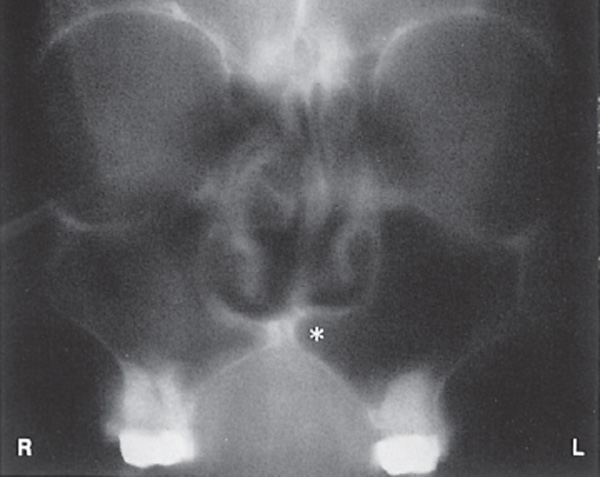
Fig. 2.24 Pronounced palatine recess (*) of both antra running under the floor of the nose. Coronal cut through the sinuses (polycyclic tomography).
The posterior attachment of the middle turbinate can be readily identified on a CT scan, lying on the lateral nasal wall just in front of the floor of the sphenoid sinus, at the point where the wall becomes thicker due to the base of the pterygoid process.
The superior turbinate is often overlooked by the surgeon, and it may be represented only by a slight swelling, in which case the superior meatus is difficult to define. However, the superior turbinate is often well developed and can be confused with the medial turbinate on cursory examination. The CT scan illustrates its slender structure and its suspension from the dome of the nose at the point where the medial turbinate is running more deeply to insert into the ethmoid, at the level of the posterior edge of the crista galli. Occasionally, a supreme turbinate is also present. Understanding of the three-dimensional structure of the ethmoids is mandatory for the intranasal surgeon. The main features are constant, but the individual shape of the ethmoid varies so much that it is scarcely worthwhile identifying or naming individual cells. The most important landmarks are the following:
• The semilunar hiatus and its rostral prolongation
• The ethmoid infundibulum
• The uncinate process
• The ethmoid bulla forming the foundation wall of the anterior ethmoid cells
• The posterior wall of the bulla forming the anterior boundary (basal lamella) of the posterior ethmoid cells
• The middle turbinate
• The olfactory region, particularly its anterior and posterior limits
• The agger nasi
• The frontonasal duct or its equivalent in the form of ethmoid duct cells
• The primary maxillary ostium
The endoscopic image of the semilunar hiatus has already been described above. Its gutter is halfmoonshaped, curving forward and upward, and is usually only visible in CT if 2 mm slices at 2 mm intervals are used. Posteriorly it is 1–2 mm high, but anterosuperiorly it often forms a 3 mm deep ethmoid infundibulum (Fig. 2.25) Posteriorly it extends a good 3 mm in a trough shape. The canal between the infundibulum and the antral cavity is shown in the sections in Fig. 2.22 i (right) and Fig. 2. 22 h (left): it is not a true ostium but rather a tunnel several millimeters long.
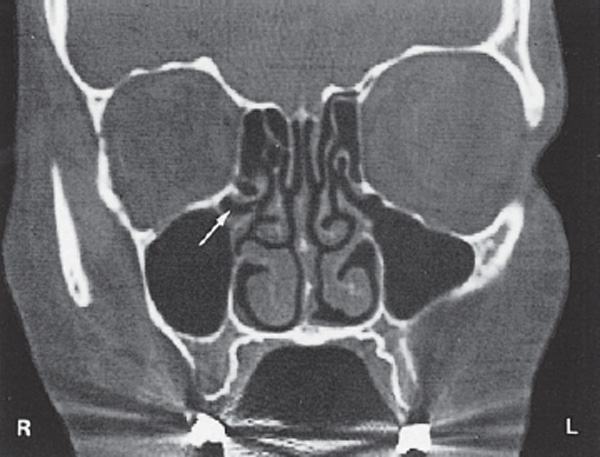
Fig. 2.25 Depression of the semilunar hiatus forming the ethmoid infundibulum (marked with an arrow) in a coronal cut on the right side. The uncinate process projects beyond the gutter by 2 mm.
The inferior wall of the hiatus is formed by the uncinate process, whose thickness and height vary (see Fig. 2.22 g–i, patient’s right side, and Fig. 2.22h–i, patient’s left side) . During middle meatal antrostomy it forms a barrier, at least in the posterior half of the middle meatus, and must often be removed to allow an antrostomy to be created large enough to permit manipulations within the antral cavity.
The ethmoid bulla projects in an inferomedial direction over the semilunar hiatus (see Fig. 2.22 g right side, Fig. 2.22h left side) . Several ethmoidal cells of varying size lie above the hiatus and drain into it, and are thus classified as anterior ethmoid cells. However, they do not form the lateral boundary because ethmoid cells are present lateral to the bullar cells and lateral to the semilunar hiatus (see Fig. 2.22h left) . This fact is easily overlooked during overtimorous removal of the bulla anteriorly, so that complete ethmoidectomy is better achieved by concentrating on the lateral nasal wall as a landmark. The length of the bulla varies between 4 and 8 mm. At its posterior edge there is said to be a bony wall running obliquely in an anterosuperior direction, the basal lamella of the middle turbinate, or the floor of the posterior ethmoid cells. However, in practice this “party wall” is often not found, so that the posterior ethmoid cells are also opened during anterior ethmoidectomy.
The definition of a boundary between the intraconchal cells of the middle turbinate, the bulla cells, and the posterior ethmoid cells is of theoretical rather than practical importance. Complete removal of this boundary zone can easily damage the medial lamella of the middle turbinate, resulting in damage to the olfactory region. The turbinate cells (most anterior medial ethmoidal cells), recently focused on by Braun and Stammberger (2003), can easily be seen lying under the lateral olfactory region in the sections in Fig. 2.22 f and g. Their removal must therefore greatly weaken the anterior suspension of the middle turbinate.
Endoscopic identification of the relation of the anterior ethmoid cells to the frontal sinus is vital. This boundary zone often varies between the two sides, and particularly between different subjects (see Fig. 2.22d) ; ethmoid cells sometimes penetrate far laterally. It is impossible to expose this area without resecting the agger nasi. Anteriorly at this point can be seen the medial boundary of the ethmoids formed by the lamella inserting into the skull base (see Fig. 2.22g) . The frontonasal duct can occasionally be recognized on sagittal sections, but not in frontal projections. Figures 2.22 d and e illustrate the distance from the semilunar hiatus of small ethmoid cells surrounding the duct. It is easier to distinguish the posterior ethmoid cells from the sphenoid sinus. It is usually possible to recognize the party wall easily on a CT section by following the lateral ethmoid and nasal wall, and taking the end of the middle turbinate as a landmark. This point will not be mistaken either by endoscopy or under the microscope if the surgeon sticks to the posterior end of the middle turbinate as a landmark. Occasionally an Onodi cell extending laterally under the optic nerve may render orientation difficult, and careless radical removal with the sharp punch may endanger the optic nerve.
CT imaging of the sphenoid sinus may demonstrate the wide variation of size between the two sides and individual recesses extending deeply into the pterygoid process (Fig. 2.26). A pronounced inferolateral recess can be found in about one-third of all subjects, lying immediately adjacent to the bone over the nerve of the pterygoid canal and the maxillary nerve. The fl oor of the sphenoidal sinus has no significant structures except bone, and the only complication of excessive resection is bleeding from branches of the sphenopalatine artery: in contrast, the lateral wall of the sinus carries the optic nerve, the internal carotid artery, and the cavernous sinus. Its position relative to the sinus cavity can readily be seen on CT images. A well-developed superolateral recess between the optic nerve and the internal carotid artery is found in about 20% of sphenoid sinuses. Fig. 2.26
Before undertaking his first endoscopic ethmoid operation on patients, the surgeon must be intimately aware of the shape of the anterior base of the skull, as it appears on intranasal exposure. CT is helpful because it shows clearly the danger zones during intranasal manipulations. Anteriorly, the dome of the nose projects toward the nasal bone, but the septum does not yet meet the skull base (see Fig. 2.22a–c) . Even the plane in which the anterior end of the middle turbinate arises from the agger nasi is not free from danger, because the frontal sinus lies above the septum (the frontal section in Fig. 2.22d is not absolutely perpendicular) . There is no dura lying anterior to the frontonasal duct, so the bone in front of the duct can be resected.
However, the base of the skull reaches its deepest point behind the frontonasal duct: at this point begins the olfactory fossa. This boundary is marked by the anterior edge of the crista galli lying immediately upon the septum (see Fig. 2.22e) . The depth of the olfactory groove varies widely between different subjects, and between the two sides in the same subject. Furthermore, its width increases as it extends posteriorly. The cribriform plate is perforated by olfactory fibers, and it usually lies obliquely rather than horizontally, so that the skull base and its overlying dura can lie medial to the upper ethmoid cells (see Fig. 2.22e) . The roof of the ethmoids may sometimes present a dangerous construction. Bodino (Bodino et al. 2004), however, has stressed that, instead of considering the difference of height between the cribriform plate and the ethmoid roof (Keros 1962), we should consider the vertical height of the middle turbinate lamina as a potential risk factor in ethmoidal surgery. The olfactory region is always dangerous! Behind it the slope flattens out and the sphenoid plane projects over the posterior ethmoid cells as a thick horizontal plate (see Fig. 2.22k).
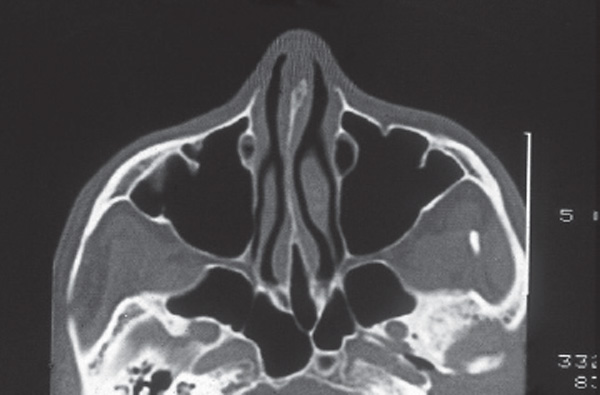
Fig. 2.26 Extensive lateral recess of the sphenoid sinus reaching into the pterygoid. Axial CT.
Stay updated, free articles. Join our Telegram channel

Full access? Get Clinical Tree


